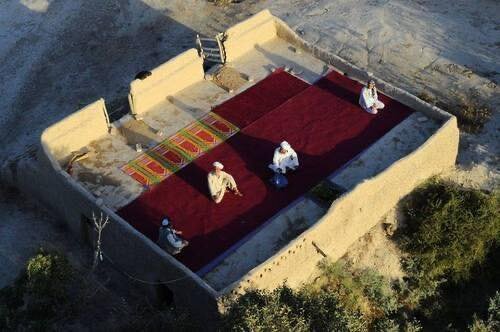Two weeks ago, the Religion Guy looked at the future of world Islam and the media after Afghanistan’s Taliban takeover. Herewith a look backward with a bit of historical and cultural perspective for writers covering this turbulent and tormented land.
As University of Washington political scientist Anthony Gill commented in the Wall Street Journal, “Despite the seeming irrelevance of religion in the secular West, policy-makers and military strategists would do well to understand its power elsewhere in the world.” In the case of Afghanistan, one good source for that is “Holy Wars: The Rise of Islamic Fundamentalism” (Routledge, 1989, reissued 2014) by British journalist Dilip Hiro, a native of Pakistan.

A big theme emerges: Anything and everything that has occurred and will occur is bound up with an especially rigid form of Islam that dominates Afghan culture. In rural villages across the countryside, where most live, mullahs with rudimentary schooling are part of the influential elite establishment.
Time and again over the past century, monarchs tried to tame the clergy and impose a somewhat flexible form of Islam only to be defeated by populist rancor. Among the issues: whether to educate girls, child marriage, modern dress vs. the veil and burqa, whether women can leave their houses without male chaperones or hold down jobs, women voting, alcohol prohibition, polygamy rules and whether to permit banks when the religion bans charging of interest.
Hiro writes that Afghanistan was “a landlocked society which clung to medieval Islam and tenaciously resisted modernization well into the last quarter of the 20th Century.” The media have well and amply surveyed the following eruptions since a 1973 military coup abolished the monarchy.
Soviet troops invaded to prop up a Marxist regime and produced the militant Muslim movement (1979). U.S.-aided Mujahideen forces won Soviet withdrawal (1989). The Taliban emerged from the resulting confusion to impose harsh theocracy (1996). Western powers and Afghan allies expelled Taliban rulers for harboring the 9/11 plotters (2001). The Taliban rapidly regain power (August, 2021).
We find pertinent data in the latest edition of the “World Christian Encyclopedia,” which belongs in every newsroom library. Afghanistan is probably the world’s most Islamized country. The faith encompasses 99% of the population, as it has consistently since 1900, outpacing even its devout neighbors Shia Iran (98.6%) and Sunni Pakistan (96.4%). (Other data: The population is 68% illiterate and 41% are under age 15, setting up fierce future competition for jobs.)
Is Afghanistan governable? In modern times it has proven not only impossible to vanquish from the outside but difficult to unite from the inside. The country is a collection of tribal fiefdoms mostly lumped together or broken up by 19th Century British and Russian imperialists. The Encyclopedia says the current borders encompass 72 ethnic groups that speak 58 languages, among which the most important are Dari (Afghani Persian), Pashto and five major regional tongues.
This ethnic diversity has continually made Islam the one powerful unifying force as unstable central regimes rise and fall. And not just any one Islam. Afghanistan is shaped by three strict Sunni ideologies, the dominant Hanafi school of religious law, overlaid with Islam’s anti-western Deobandi movement imported from Pakistan and India, plus Wahhabi influence fueled by wealthy Saudi Arabia.
Yet Islam is also a disunifying force. Militant Sunnis are hostile to Muslims in their religion’s minority Shia branch and to Sufi brotherhoods. For years, pro-monarchy village traditionalists jockeyed with revolutionaries. Westerners learned this past week that the Taliban are threatened by the even more bloodthirsty ISIS-K, which like its counterpart in Syria and Iraq demands a caliphate. There are other radical sects at work, al Qaeda among them.
Islam is the state religion alongside a traditionalist reading of religious law (Sharia) and its application (fiqh) that considers democracy un-Islamic. In Hanafi tradition, a Muslim’s conversion to another religion is punishable by execution for men and life imprisonment for women. Speech or writing that allegedly insults Islam are also capital crimes. The Taliban have applied literally such scriptural tenets as amputation of thieves’ hands (Quran 5:38).
There is a competing vision for Islam, proposed August 24 by Afghan legal scholar Haroun Rahimi on AlJazeera.com. He contends that Islam’s founders practiced consultation with the people and that the Quran, as opposed to centuries-old fiqh dictums, is compatible with modern democracy, pluralism and basic human rights. One wonders whether Rahimi’s young school, the American University of Afghanistan, which enrolls women, can long survive.
Reporters will want to monitor the Global Terrorism Index (.pdf here). It reports that 58% of the 9,223 terrorist murders worldwide during 2018 were perpetrated by just four organizations, all Islamist: Nigeria’s Boko Haram, the Islamic State, its ISIS-K offshoot and the Taliban.
The latter two operate in Afghanistan, which even before the Taliban triumph had supplanted Iraq in the index as the number-one national source of terrorism.
FIRST IMAGE: A simple mosque in rural Afghanistan. Image posted on Facebook.













